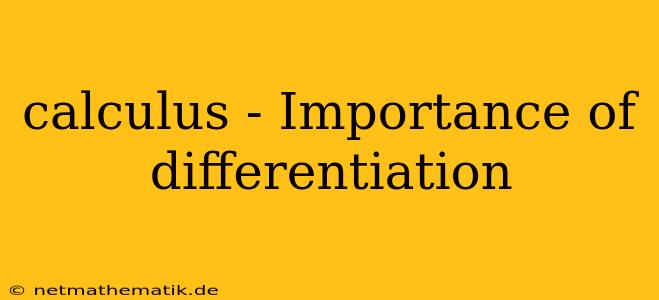Calculus, a branch of mathematics that deals with continuous change, plays a fundamental role in various scientific and engineering disciplines. Differentiation, a core concept in calculus, is the process of finding the rate of change of a function. Its significance extends beyond the realm of mathematics, impacting numerous real-world applications. Differentiation is the foundation for understanding how quantities change and how to optimize various processes.
Understanding the Essence of Differentiation
Differentiation involves finding the derivative of a function, which represents the instantaneous rate of change at a specific point. Imagine a car traveling along a road. The speed of the car at any given moment is the derivative of the car's position function. By finding the derivative, we gain insight into how the car's position is changing with respect to time.
Practical Applications of Differentiation
Differentiation finds applications in various fields, including:
-
Physics:
- Motion: Determining velocity and acceleration from displacement functions.
- Forces: Calculating the work done by a force acting on an object.
- Electromagnetism: Analyzing electric and magnetic fields.
-
Engineering:
- Optimization: Finding the maximum or minimum values of a function, which is crucial in designing efficient structures and processes.
- Fluid Dynamics: Modeling the flow of fluids and analyzing their behavior.
- Control Systems: Designing and implementing control systems for various applications, from aircraft autopilots to industrial robots.
-
Economics:
- Marginal Analysis: Determining the rate of change of cost, revenue, and profit with respect to changes in production or consumption.
- Optimization: Finding the optimal production level for maximum profit.
-
Biology:
- Population Growth: Modeling the growth of populations and analyzing factors influencing their dynamics.
- Drug Kinetics: Understanding how drugs are absorbed, distributed, metabolized, and eliminated from the body.
Importance of Differentiation in Problem Solving
Differentiation is a powerful tool for solving real-world problems. It allows us to:
- Analyze rates of change: By finding the derivative, we can determine how quickly a quantity is changing at a specific point. This information is crucial for understanding various phenomena, such as population growth or the spread of disease.
- Optimize processes: Differentiation enables us to find the maximum or minimum values of a function, which is essential for optimizing various processes, such as maximizing profits in a business or minimizing costs in manufacturing.
- Model physical phenomena: Differentiation is used to create mathematical models that accurately represent physical phenomena, such as the motion of objects or the behavior of fluids.
- Solve equations: Differentiation is a key tool for solving differential equations, which are used to describe many real-world processes, including the growth of populations, the flow of heat, and the behavior of electrical circuits.
Examples of Differentiation in Action
Differentiation is applied in countless practical situations. Here are some examples:
- Finding the maximum height of a projectile: By differentiating the equation describing the projectile's trajectory, we can determine the point where its vertical velocity becomes zero, which corresponds to its maximum height.
- Optimizing the design of a container: Differentiation can be used to find the dimensions of a container that minimize its surface area while maintaining a specific volume, thereby reducing material costs.
- Analyzing the rate of change of a stock price: Differentiation allows us to calculate the instantaneous rate of change of a stock price, which can provide valuable insights for investors.
- Modeling the spread of a virus: Differentiation can be used to model the spread of a virus and estimate the number of infected individuals over time.
Conclusion
Differentiation is an essential concept in calculus, with far-reaching implications in various scientific and engineering disciplines. Its ability to analyze rates of change, optimize processes, model physical phenomena, and solve equations makes it an invaluable tool for addressing real-world problems. From understanding the motion of objects to designing efficient structures, differentiation plays a crucial role in advancing our understanding of the world around us.
